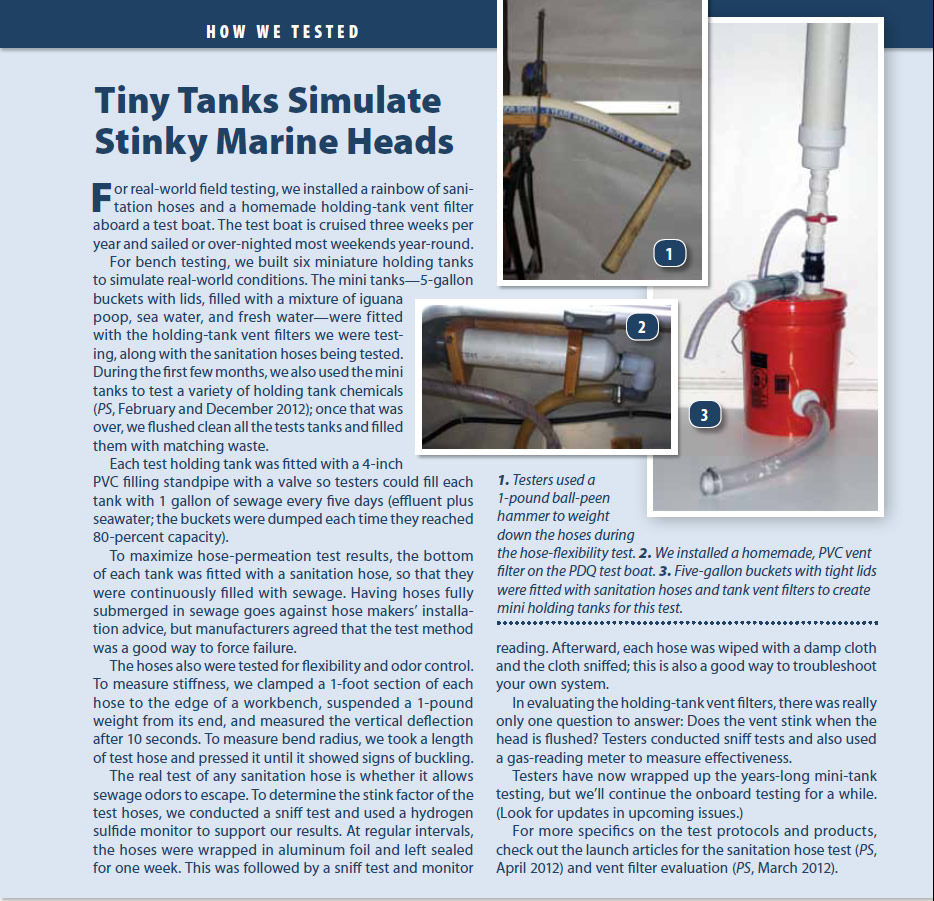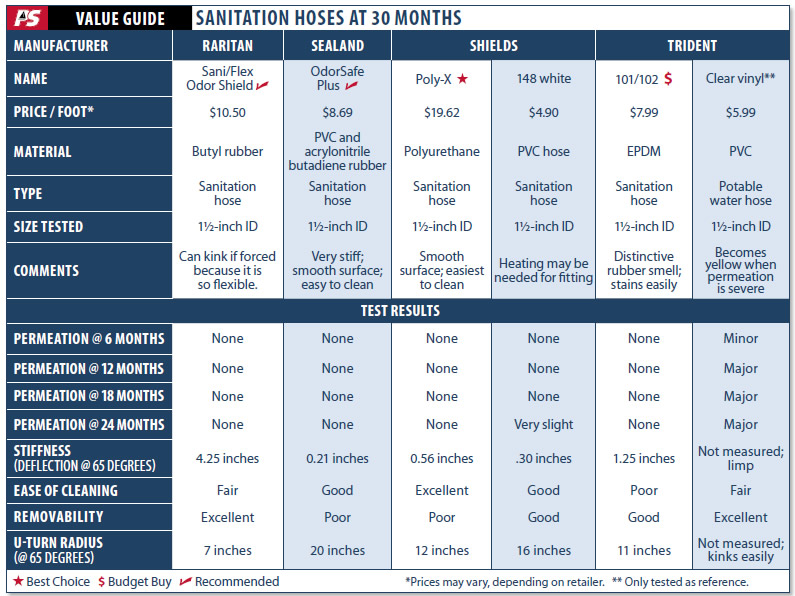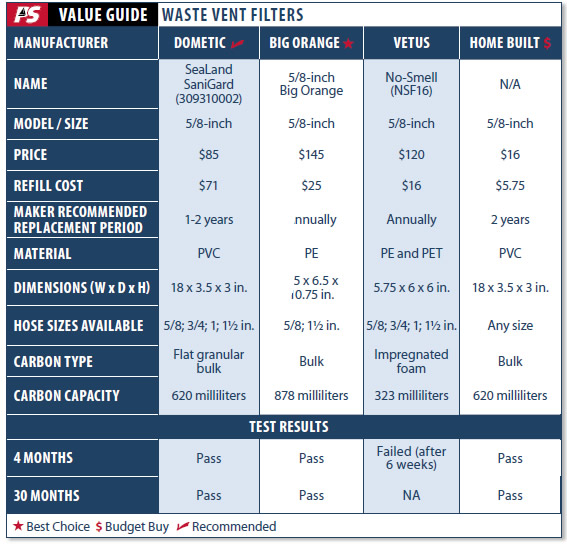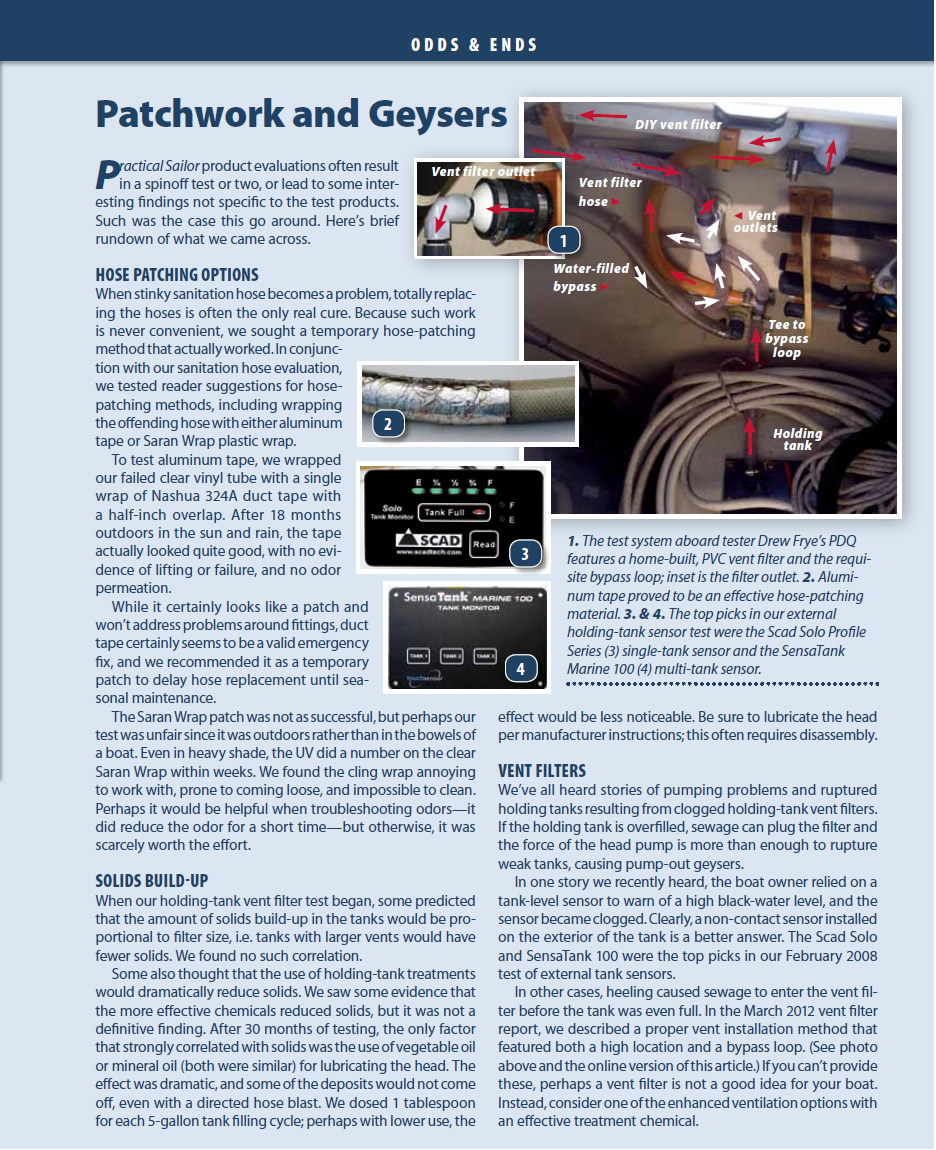Photos by Drew Frye and courtesy of manufacturers

A few years ago, we launched a series of product tests aimed at ridding a boat of head odors, including evaluations of holding-tank vent filters (PS, March 2012) and sanitation hoses (PS, April 2012). Both of those tests centered around the backyard bench testing of multiple miniature holding tanks and ocean testing aboard a PDQ 32 catamaran. After 30 months of testing, weve reached some solid conclusions on the hoses and vent filters-and were pleased to say that the test boat is still head-odor free. Heres the latest on both tests.
What We Tested
Both tests featured a cross-section of popular marine brands, and the holding-tank vent filter review also included a homemade system.
The sanitation hoses we tested were Trident Marines 101/102 EPDM hose; SeaLands OdorSafe Plus, a PVC and acrylonitrile butadiene rubber hose; Raritan Engineerings butyl rubber Sani/Flex Odor Shield; and Shields Marines Poly-X polyurethane sanitation hose. We added schedule 40 PVC sanitation pipe and clear vinyl hose (Trident) to the mix for comparison. PVC pipe is known to resist permeation indefinitely, but we expected the clear vinyl hose to fail in short order. We included it because its occasionally found in marine sanitations systems, always with disappointing results.
The holding-tank vent filter test field comprised our homemade system and three commercially available products: the SeaLand SaniGard from global marine sanitation manufacturer Dometic; the 5/8-inch filter from Canadian manufacturer Big Orange; and the No-Smell NSF16 from Maryland-based Vetus. All of the products use activated carbon and are intended to be installed in a 5/8-inch-diameter hose.
After our test began in 2011, Big Orange introduced a vent filter that is a drop-in replacement for SeaLand-style OEM filters. We have not tested this model.
Sanitation Hoses
Proper sanitation hoses are specifically designed to contain odorous gases. They are made of very different materials than similar-looking hoses that are used for fuel, coolant, and tap water, and are not interchangeable with these.
The one-year update on our sanitation hose test offered preliminary results for which hoses were easiest to install, which resisted permeation in the near term, and some ins-and-outs of installation. In the 18 months since that report, weve learned a few more things from the head-to-head mini-tank testing and from our test boat, which has been sailing with its odd assortment of hoses, wracking up real-world miles and exposure. For details on our test protocol, see How We Tested.
We can report that at 30 months, all of the premium marine test hoses (Trident 102, Raritan Odor Shield, Shields 148, Shields Poly-X, and OdorSafe Plus) are performing perfectly, without permeation, fittings leaks, or hose kinks.
Predictably, the clear vinyl hose is gradually turning yellow and stinking more and more. The standard white sanitation hose (Shields 148) test sample may be permeating a tiny bit; testers opinions were mixed during the string of observation tests.
Shields 148
The Shields 148 is standard, white, flexible PVC sanitation hose. Its easy enough to clean, but youll need a brush and some effort to get the grooves clean. Its very stiff, often requiring hot water to make it pliable enough to slide onto fittings.
Testers noted no permeation at 24 months, but possible permeation at 30 months.
Bottom line: This is a common and inexpensive option ($4.90 per foot, the cheapest tested), but there are better products out there. The Shields 148 is widely available in smaller sizes that other hoses are not, making it useful for vent lines. However, even with the 148, our opinion holds true for common white sanitation hoses: not recommended.
SeaLand OdorSafe Plus
An upgraded white sanitation hose with different polymer chemistry, Sea-Lands OdorSafe Plus is well respected and had no signs of permeation at 30 months. It also has done well in previous Practical Sailor testing (PS, September 2000).
One drawback is that its very stiff, often requiring hot water to soften before sliding onto fittings. Its reasonably easy to clean, except the grooves, which require a brush and some elbow grease.
Bottom line: Priced in the middle of the pack at $8.69 per foot, OdorSafe Plus earned testers Recommendation.
Trident Marine 101/102
Trident Marines premium 101/102 hose is a little stiff and a bear to clean-our test sample had stubborn stains that would not come off-but its a very dependable product, and despite its stiffness, testers found it easy to fit during install.
There were no permeation failures at 30 months. Priced at $7.99 per foot, the 101/102 offers the longest service life per dollar.
Bottom line: A very close second pick, Tridents 101/102 is a better value than Shields Poly-X, and it is a good choice if ease of cleaning is not your top priority. It earns the Budget Buy pick.
Shields Marine Poly-X
Shields Marine Poly-X is another hose with a flawless track record. It showed no permeation at 30 months, and it comes with a lifetime warranty against permeation.
Only the vinyl hose was stiffer than the Poly-X, but testers noted that the Poly-X was not difficult to push onto fittings. Testers also noted that cleaning it was a breeze; it resisted mildew to an amazing extent and was cleaned with a quick wipe of a cloth without any need for soap.
At $19.62 per foot, Poly-X was the most expensive hose tested, but sometimes, you get what you pay for.
Bottom line: The high-quality Marine Poly-X is the Best Choice among the sanitation hoses we tested.
Raritan Sani/Flex Odor Shield
Raritans Sani/Flex Odor Shield, permeation-free at 30 months, was the hands-down easiest hose to work with. The very flexible, butyl rubber hose was much easier to fit than any other tested hose. Were looking forward to gaining more field time with this product as it is certainly the most user-friendly in tight spaces.
Cleaning ease was average: It took some effort, but no stains remained.
Bottom line: Priced at $10.50 per foot, Odor Shield is a Recommended product.
Trident clear vinyl
Trident Marine does not recommended using its clear vinyl hose for this application, but we included it in the test to show why clear vinyl hose is a bad choice for sanitation systems.
Testers noted that it is very prone to kinking-even when its bent on a long radius-making it unsuitable for use in vent lines. The clear vinyl hose section installed on the test boat became badly permeated, with odor becoming quite noticeable after about 18 months. The hose had also kinked and collapsed, so testers replaced all clear vent lines with Shields 148 sanitation hose.
PVC sanitation hose or rubber exhaust hose is a better choice than clear vinyl hose. We recommend all vent hoses be sanitation hose; generally only 148-series white vinyl hose is available in the small sizes required.
Bottom line: Clear, soft vinyl tubing-by any brand-has no place in sanitary plumbing.
Conclusion
After 2 years of mini-holding-tank testing and onboard use, no premium sanitation hose has shown any permeation. The long-term, on-boat observations will continue.
Our recommendations at the 30-month mark mirror those we made in the one-year test update. The Shields Poly-X, a standout thanks to its ease of cleaning, held on to its spot as Best Choice, and the Trident 101/102, which is preforming predictably well, is still the Budget Buy. Testers Recommend the SeaLand OdorSafe Plus and the flexible Raritan Sani/Flex Odor Shield, which we will be monitoring to see how it does in the longer term on the test boat.
Vent Filters
While proper ventilation and chemical treatments are the most common approaches to curing holding-tank odor, some boats require a more direct approach. Adding a holding-tank vent filter filled with activated carbon to a sanitation system can stop even the foulest stench. The downside is that they can become clogged if not installed properly or if the holding tank is overfilled; this can lead to a ruptured holding tank-a stinky prospect for sure.
After two Chesapeake Bay summers and 30 months of testing, the lone failure among the holding-tank vent filters we tested was the Vetus No-Smell. As we reported in the March 2012 issue, the Vetus NSF16 uses a carbon foam adsorbent pack that failed after six weeks of testing. Interestingly, after each failure, the No-Smell recovered during the cooler weather of the off-season-when reduced biological activity minimized the load on the filter-but it would again fail when temperatures rose.
Following this test, PS filled the Vetus No-Smell NSF16 with bulk silica gel for our fuel-tank vent test (PS, January 2013). PSs retrofit was successful in fuel-tank venting; however, we did not try it with holding tanks. In the wake of the fuel-vent test, Vetus is coming out with a new vent filter, the No-Smell NSFCAN, in January. According to Vetus, the NSFCAN solves the problems we had with the NSF16 because it uses a combination of activated bulk carbon and bulk silica gel as the adsorbent media. We plan to test the new Vetus filter once it is released.

Dometic SeaLand SaniGard
The 5/8-inch SeaLand SaniGard is a simple but effective vent filter that uses bulk carbon. A 12-inch length of 2-inch PVC pipe with custom end fittings, the SaniGard comes with minimal mounting hardware. One drawback testers noted was that when its time for a refill, you have to replace the entire canister, which costs 85 percent of the price of an $85 new unit.
Based on its own lab studies, the maker claims its carbon is far more effective than competing filters; industry practice confirms that certain types of carbon are more suited to odor removal than others.
Bottom line: The Dometic/SeaLand is comparatively expensive to refill, but it uses good-quality carbon and was still performing well after 30 months. It gets our Recommendation.
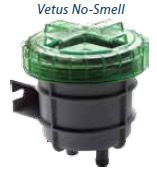
Vetus No-Smell
The 5/8-inch Vetus No-Smell NSF16 vent filter was the only product tested that uses a carbon-impregnated filter media rather than bulk carbon. Because the filter is marketed for use as both a holding-tank filter (NSF16) and a diesel fuel-tank vent filter (NSF16DS), we also included it in our fuel vent test (PS, January 2013).
The Vetus No-Smells packaging and mounting hardware are both top quality, and the media is easily replaced, but the filters performance was disappointing in this test. The media contains far less carbon per unit volume than bulk carbon, and the No-Smells volume is insufficient for most holding-tank jobs. At $120, it was the second most expensive filter tested. We look forward to testing Vetuss new filter this winter.
Bottom line: We do not recommend the Vetus NSF16 for holding-tank use.
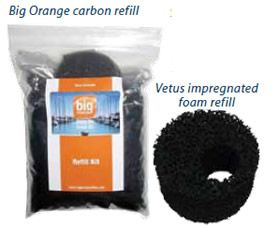

Big Orange
The largest vent filter tested, the Big Orange is the only unit on the market that includes a vacuum break valve, which is essential to protecting the holding tank in the event of filter plugging. The only flaw we noted in the design is that it is made to mount on the top of the holding tank. We feel bulkhead mounting is a better option, but a simple cleat or bracket would solve this.
Big Orange refills are either bulk carbon from the manufacturer ($25), or you can find your own local bulk-carbon source; many pet and aquarium stores carry it. Changing the carbon couldnt be easier: Pull out the carbon tray, dump the old carbon, and fill with new carbon.
After 30 months in a tough test environment, the carbon tray slid right out with the gaskets in good shape, and we refilled it without spills in just minutes.
Big Orange now makes a smaller inline vent filter that is a drop-in replacement for SeaLand-style OEM filters. Unlike the SeaLand-style filters, the Big Orange OEM replacement ($115) has the same features testers liked in the original Big Orange. The OEM replacement also has a built-in, vacuum-break valve that prevents holding tank pump-out difficulties and collapse concerns, in the event the filter become plugged, and it is easy to refill.
Bottom line: The most expensive filter we tested ($145), the Big Orange also offers top features and a lower long-term operating cost than some of the other test products. The recipient of PSs Editors Choice title in 2012, the Big Orange filter holds on to its Best Choice pick and will be installed on the test boat for extended testing.

Homemade Vent Filter
Dimensionally identical to the SaniGard, the vent filter we built was also based on 12 inches of 2-inch PVC pipe. We tapped NPT-to-garden hose adapters into the PVC end caps, but hardware-store bushings could also be used.
The DIY filter used in the mini-tank testing was not designed for refill; however, we built a second filter of similar design for the test boat, and it was refillable. The refillable filter has one end cap held in place with a 2-inch no-hub connector-a simple hose with two clamps available in any hardware store-instead of being glued on. We mounted it in a wooden saddle, but two 2-inch PVC conduit clamps would make a simple, durable, and inexpensive bracket.
After 30 months, the homemade vent filter on the test boat is still going strong and is more than 90-percent effective, reducing head odors well below the point of offence.
Bottom line: If youre at all handy, theres no reason you can’t fabricate a durable, economical, refillable filter with common tools. This option is our Budget Buy.
Conclusion
After 30 months of testing the holding-tank vent filters, there are no odor or hardware problems to report. The expensive but effective Big Orange filter is still our Best Choice, and we Recommend the SaniGard filter, or building your own vent filter.
We have confirmed that manufacturers single-season replacement advice is very conservative, and that an average sailor can expect much more service life from a single fill-up-perhaps the three to five years generally reported from the field. At that rate, vent filters become a simple and economical approach to controlling head odors, especially when compared to regular chemical treatments (PS, February 2012 and December 2012). Plan to replace filter media every year or two, but be sure to inspect the vents more frequently to ensure there are no system clogs. The vents will last longer if they are protected from salt water and holding tank overflow.
